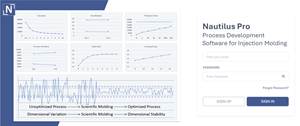Part 1: The Importance of Consistent Fill Time
To make identical parts, you need to keep fill time constant. Here’s why.
Molding is a complex process. If there are any doubts, consider the number of settings on injection molding machines, the complexity of the various controllers, the number of variables in the process and the significant fact that identical settings do not produce identical results. So, where you start?
Pick the variables you want to control and prioritize them. I wish there were a consensus as to which ones to watch, but I have yet to see it. One strategy is to track as many as possible, but few can interpret that much data. I follow Dr. Deming’s strategy: Fewer is better. First on my list to produce consistent functional parts is fill time. Fill time is defined as the time from the start of injection to when the screw reaches the transfer position, filling 90–99.9% of the part by volume. It is a “result,” not a setpoint.
Why is controlling fill time important? Basically, it is because the viscosity of plastics changes during production. To make identical parts, ideally you want the plastic to flow or fill the part or parts identically. If you have viscosity changes the flow pattern and balance to fill your parts will change. Parts will not be identical. Keeping fill the same attenuates viscosity changes. So, controlling fill time is critical. Before we go into the how to control fill time, let’s review the causes of viscosity change, some of which you can control and others you cannot: Here is my list:
1. Fill time. This is the main point of the viscosity curve: Plastics change viscosity if you change fill time. Plastics are shear-sensitive; that is, resins change viscosity dramatically with changes in injection speed. To make identical parts, you need to keep fill time constant. Believe it or not, shear has a larger impact on resin viscosity than temperature.
2. Resin temperature. Any variation in melt temperature due to barrel heaters or hot runners change melt viscosity
3. Moisture content. Certain hygroscopic resins, like PC, nylon and PET, will suffer chain degradation due to hydrolysis if not dried properly. It’s not just splay you need to worry about. Infinitesimal amounts of residual water will greatly influence the viscosity of these materials. This amount of water is so small that you will not see splay in the part or foam at the nozzle, but it will react with the polymer and break the polymer chains. This reaction actually consumes water, reduces the viscosity and produces good-looking parts that will fail in end-use.
3. Lot-to-lot changes. Though certified to be within the specifications, resin lots can and do differ in viscosity.
4. Screw-rotate time. Since most of the energy to melt the plastic comes from the mechanics of the screw geometry and rpm, changes in screw-rotate time--a result, not a setpoint--cause viscosity variations.
5. Additive type and quantity. Usage of colors, fillers, mold releases, flow aids, antistats, antioxidants, regrind, etc. have an impact on viscosity. The quantity, type, size, how well mixed, etc. all add to the complexity of melt viscosity.
6. Mold temperature. The melt behaves as if the viscosity changed if you have a hotter or cooler mold.
With all these variables in viscosity, keeping fill time constant minimizes their influence and provides a more stable process and therefore consistent parts. Even though the resin can start out at a different viscosity, if driven to the same shear rate, viscosity variations are minimized, which provides a more consistent process.
Once you find a fill time that makes good parts, it is the fill time for the life of the mold. So how do you maintain that fill time? There are differences of opinion in the industry. In Part 2 I will cover how to keep fill time constant, along with procedures to check out your machines.
Bottom line: Run to run, shot to shot, summer to winter, and machine to machine, keep fill time the same and your process will be more consistent.
ABOUT THE AUTHOR: John Bozzelli is the founder of Injection Molding Solutions (Scientific Molding) in Midland, Mich., a provider of training and consulting services to injection molders, including LIMS, and other specialties. Contact john@scientificmolding.com; scientificmolding.com.
Related Content
Use These 7 Parameters to Unravel the Melt Temperature Mystery
Despite its integral role in a stable process and consistent parts, true melt temperature in injection molding can be an enigma. Learning more about these seven parameters may help you solve the puzzle.
Read MoreOnline Versions of Process Development Course and Software Launch
NPE2024: FimmTech is introducing online versions of its Nautilus process development software as well as its Scientific Molding and Design of Experiments (DOE) process development course.
Read MoreRead Next
See Recyclers Close the Loop on Trade Show Production Scrap at NPE2024
A collaboration between show organizer PLASTICS, recycler CPR and size reduction experts WEIMA and Conair recovered and recycled all production scrap at NPE2024.
Read MoreFor PLASTICS' CEO Seaholm, NPE to Shine Light on Sustainability Successes
With advocacy, communication and sustainability as three main pillars, Seaholm leads a trade association to NPE that ‘is more active today than we have ever been.’
Read More
.jpg;width=70;height=70;mode=crop)

















